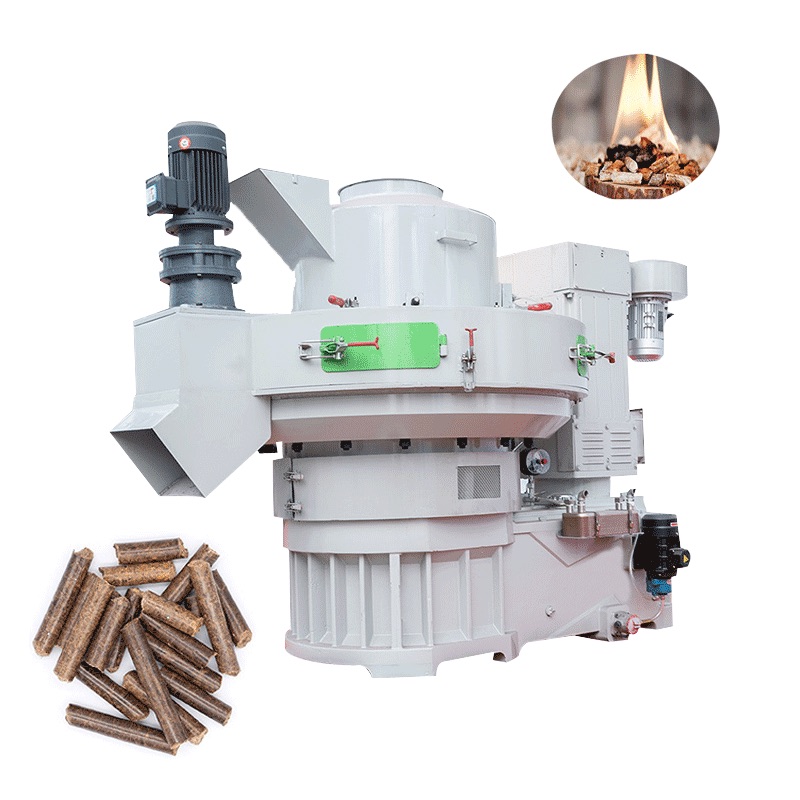
All over the world, people have been using wood pellets for a variety of purposes. Not only do they act as fuel to fire but also make good bedding for animals.
In the United States, wood pellets have become a well-accepted fuel for heating residential and commercial properties in winters. Apart from this, individuals use wood pellets for cooking, industrial boilers, and power plants.
In several European countries, cogeneration power plants utilize wood pellets to run turbines and generate electricity.
According to a report, the European Union collectively used 26, 1 million tonnes of wood pellets in 2018. Out of which, 65.5% of pellets were used for residential and commercial heating only. The remaining 39.5% of pellets were used for power production.
The good thing is that making wood pellets is easy if you have a quality pellet mill. You can make them using compressed wood leaves, shavings, chips, sawdust, slabs, and other wood waste.
As prices of natural gas and fossil fuel are skyrocketing, people have started showing interest in wood pellet heating. You can cut your fuel costs in half by using wood pellets. Moreover, wood pellets are a sustainable energy source with low emissions.
In this post, you will learn to make your own wood pellets step-by-step. Before that, let us have a quick look at its market growth.
The demand for wood pellets has been rapidly increasing. As per the market research, the global wood pellet market would reach USD 23,892.77 million by 2028 with a CAGR of 12.1%. The use of wood pellets for heating will account for a sizable market share.
These figures clearly show that making wood pellets is a profitable business. If you make wood pellets for yourself only, you can save a substantial amount of fuel that you would otherwise use for home heating. Thus you can save hundreds of dollars every year.
Let us learn how to make your own wood pellets using a pellet mill.
Making of Wood Pellets Using a Small Wood Pellet Mill

If you search the term pellet mill for sale on Google, you will find a wide range of wood pellet mills online. The choices are endless.
Nevertheless, if you want to make pellets for household use, go for a compact-sized wood pellet maker.
Step 1: Gathering Raw Material and Resizing
You can make your own wood pellets using a wide range of wood waste. It includes wood shavings, sawdust, wood logs, and wood chips.
You will require about 8 to 10 logs or 4 to 5 buckets of sawdust to make a medium batch of wood pellets. Such raw material is readily available in a local sawmill or lumber yard.
Besides, you can also use other biomass materials, such as grass leaves, corn cobs, and stalks.
Once you have accumulated the raw material, reduce them to the size of about 6m. If you are using sawdust, skip this process.
You can use a hammer mill to grind and chop the large wood pieces. If you do not want to buy it, rent it from your local lumber yard.
The speed of a hammer mill can range from 3000 to 8000 RPM. At the same time, the size of the hole in the machine may go from 1mm to 10nm.
Remember, the moisture level of your raw material must be between 10 to 20%. Since you have a small batch, let it dry naturally for a few hours.
If you are not sure about the moisture level of your raw material, you can buy a moisture meter. It is available online or at most agriculture stores.
Make sure there is no contaminant in the raw material. Use strainers and magnets to eliminate unwanted particles.
Step 2: Pelletizing
It is time to use your flat die pellet mill. Start your homemade wood pellet machine and let it reach the optimum temperature that is (170–190 °F).
Next, transfer the dried raw material to your wood pellet maker. Your pellet mill’s roller will apply pressure to the raw material so that it can pass through the die’s holes.
Do not add all the raw materials at once. Feed it to the machine slowly. It will minimize the chances of deformed pellets.
Various types of small pellet mills for sale are available in the market. For example, you can choose a pellet mill with a rotating die and rotating roller.
Additionally, wood pellet mills also come with different types of engines, including gasoline engines, diesel engines, electric engines, and more.
Step 3: Packaging
Let your wood pellets cool before packaging. Eliminate the deformed pellets, and pack them into quality bags for transportation.
If you are making wood pellets for your own use, use malformed pellets as well.
How to Make Your Own Wood Pellets Using a Pellet Plant
If you want to start a pellet-making business on a large scale, you will need to set up a pellet plant. There is a difference in the production of pellets through a plant or a small pellet mill machine.
Let us find out how you can make pellets at a pellet plant.
Generally, a pellet production line consists of a pellet machine, drum chipper, hammer mill, dryer machine, cooling machine, and packaging machine.
We can part the complete process into the following steps.
Step 1: Reduction of the size of raw material
Regardless of the type of wood pellet mill you use, you will need to pre-process your raw material. So chip the wood logs, branches, and other raw material into the pieces. You will need to use a wood chipper for this process.
Step 2 Drying
Before you put raw material into your pellet mill machine, dry it for a while. You can use the drum dryer for this process.
The dryer releases the high temperature for the drying process. It features a tumbler that exposes raw material to hot air.
Alternatively, you can utilize a flatbed dryer that releases a comparatively low temperature.
Do not forget that you do not have to overdo this process. Maintain the appropriate moisture content of 8 to 10%
Step 3: Initial Sieving
This step involves eliminating impurities from raw material. When you make a large batch of wood pellets, there is a possibility that raw material may contain metal, plastic, stone, etc.
Pour all your raw material into the sieve to eliminate unwanted particles. If there are large stones, you can manually remove them. Metal particles will get removed from the conveying belt with the help of a magnet.
Sieving is a crucial process that you should not skip at any cost. Otherwise, your pellet mill can get damaged.
Step 4: Grinding
It is another crucial step in making wood pellets for commercial purposes. You put your filtered raw material into a hammer mill. Thereafter, the mill crushes the wood into 5mm diameter.
Remember, a hammer mill can process wood material that is no more than 50mm. Therefore, we reduce the size of large wood branches and wood logs through a wood chipper, as mentioned in the 1st step.
Step 5: Pelletizing
Once your raw material has appropriate moisture and size, it is time for pelletizing. For the large pellet plant, we use a Ring die pellet mill. It can produce up to 1 ton of wood pellets per hour.
On the other hand, a Flat die pellet machine can produce 500kg pellets per hour.
Ring die pellet machines are available in two versions: Vertical ring die pellet mill and Horizontal Ring Die pellet mill.
In the Vertical Ring Die pellet machine, the rotating roller & ring die make huge pressure. As a result, raw material enters the die holes and becomes pellets.
This machine is ideal for processing lightweight raw materials such as rice hull, straw, grass, fruit hull, and more. After all, these materials are not easy to form.
As opposed to the Vertical Ring Die pellet mill, the Horizontal Ring Die pellet machine features a feeding auger that feeds the raw material into the pelleting chamber.
In the sealed pelleting chamber, the material becomes soft. And then it is pressed into the die holes with the extrusion between the rotating ring die and the roller. The uniform pellets come out from the die holes that are cut by the knife.
Step 6: Cooling
When wood pellets come out of the pellet mill, they are hot and moist. It is crucial that you let them cool.
If you make a small number of wood pellets, spread them out on a surface and let them dry and cool naturally. However, when we make wood pellets in large quantities for commercial purposes, we have to use an industrial cooler or freezer to maintain the demand and supply.
Cooling is necessary to provide your wood pellets with excellent shape and strength. When pellets leave the pellet mill machine, they are extremely hot. As a result, they might get deformed if you do not let them cool immediately.
After the cooling, the moisture content in the pellets should be at least 6%. Once they are cool enough, they reach the storage shed via a conveyor belt.
Step 7: Final Filtering
After cooling, it is time for the final screening. Since you will be shipping pellets to your customers, ensure they have a perfect shape, size, and finishing.
Remove uneven, cracked, or deformed wood pellets. If you do not want to waste them, you can sell them at a low price in your local market.
Step 8: Storage and Packaging
All your hard work can go to waste if you do not store and pack your wood pellets in a better way.
You can use small bags and totes to pack your pellets. Make sure they have high-quality plastic. The bags must be airtight, stackable, and waterproof.
If you meet the huge demand for wood pellets, you can invest in an automatic packaging machine. Several large and medium-sized pellet production lines use this machine to save time and labor.
The demand for wood pellets naturally decreases during the summer. As a result, you must establish a suitable storage place for wood pellets.
Always store your pellets in a dry place. They should not catch fungus that flourishes in wet conditions.
Remember, moist pellets will not burn appropriately and make excessive smoke while burning.
Give your pellets a consistent temperature during the storage.
Check out if you need to control humidity in the storage area. The low humidity environment is ideal for pellet storage.
Keep your wood pellets away from all water sources.
Similarly, avoid heat sources. As wood pellets are highly flammable, do not store them near any heat source, such as a fire table, heater, furnace, etc.
Always raise your wood pallets off the ground as the ground could be hotter and colder than the temperature.
Label your pellet containers. It will help you know which stocks are fresh and which are old.
In the right environment, wood pellets can last for about six months.
Wood pellets are in huge demand all over the world. It is going to be a profitable business if you make wood pellets.
You can also make your own wood pellets for your home heating needs. Thus you will save a significant amount of money that you would have spent on gasoline and oil.
Let us find out why wood pellets are an ideal choice in modern times.
- Wood pellets are affordable fuel for home heating than oil, gas, and standard electric heaters.
- They produce consistent heat for a long period.
- They are carbon neutral and release less carbon dioxide to the environment than burning logs.
- They also contribute to the conservation of landfill resources since you utilize a lot of wood and other leftovers as raw material.
- Since they burn with high efficiency, they release fewer pollutants.
- Because wood pellets and their raw materials are acquired and produced locally, it supports employment and brings business possibilities to local communities.
All-in-all, making wood pellets is a lucrative business provided that you have a suitable pellet mill.



Deja una respuesta